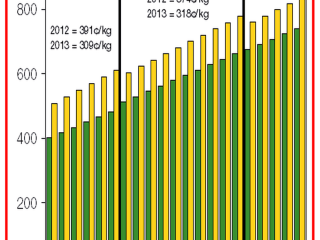In an analysis of the average prices paid for cattle included in the Eastern Young Cattle Indicator this year, Meat & Livestock Australia’s market intelligence team says the old adage that ‘weight beats rate’ is holding true
 Australian cattle prices have been under heavy pressure for the entire duration of 2013, underpinned by the prolonged drought induced surge in supplies.
Australian cattle prices have been under heavy pressure for the entire duration of 2013, underpinned by the prolonged drought induced surge in supplies.
However, when breaking down the average price of cattle eligible for inclusion in the Eastern Young Cattle Indicator (EYCI), the old adage “weight beats rate” certainly holds true.
Interestingly, for EYCI eligible cattle, the average decline in price has been far less significant for heavy cattle, with the 201–301kg lwt bracket losing 82¢, to average 309¢/kg cwt in 2013 (or for a 250kg lwt yearling, a decline of $107, to $402/head), while the 401–501kg lwt category averaged 41¢ lower over the same period, at 316¢/kg cwt (or for a 450kg lwt yearling, a decline of $95, to $740/head). Furthermore, the lightest weight bracket (201–301kg lwt) has moved from averaging the highest price in 2012, to the lowest in 2013.
In 2012, despite the 201–301kg lwt category being the most expensive on a ¢/kg basis, in $/head terms, a 250kg lwt yearling ($509/head) was $172/head cheaper than a 350kg lwt yearling, which averaged 17¢/kg cwt less, at 374¢/kg cwt. Indeed, there are occasions when the heavier end of the lighter weight bracket outweighs the lighter end of a heavier bracket, however, for 2012 average prices, the cross-over was only 10-15kg lwt. i.e. a 295kg lwt steer averaged $600/head, while a 305kg lwt steer, in a slightly cheaper weight bracket (374¢/kg cwt) averaged $594/head – producing only a slightly ($6/head) cheaper animal.
This emphasises the adage “weight beats rate” in two ways. Firstly, even when lighter cattle are more expensive on a ¢/kg basis, the additional weight of heavier cattle usually offsets the lower prices. And secondly, when conditions turn dry, and restocker interest wanes, lighter cattle lose the most ground on both a ¢/kg and $/head basis.
Source: Meat & Livestock Australia
